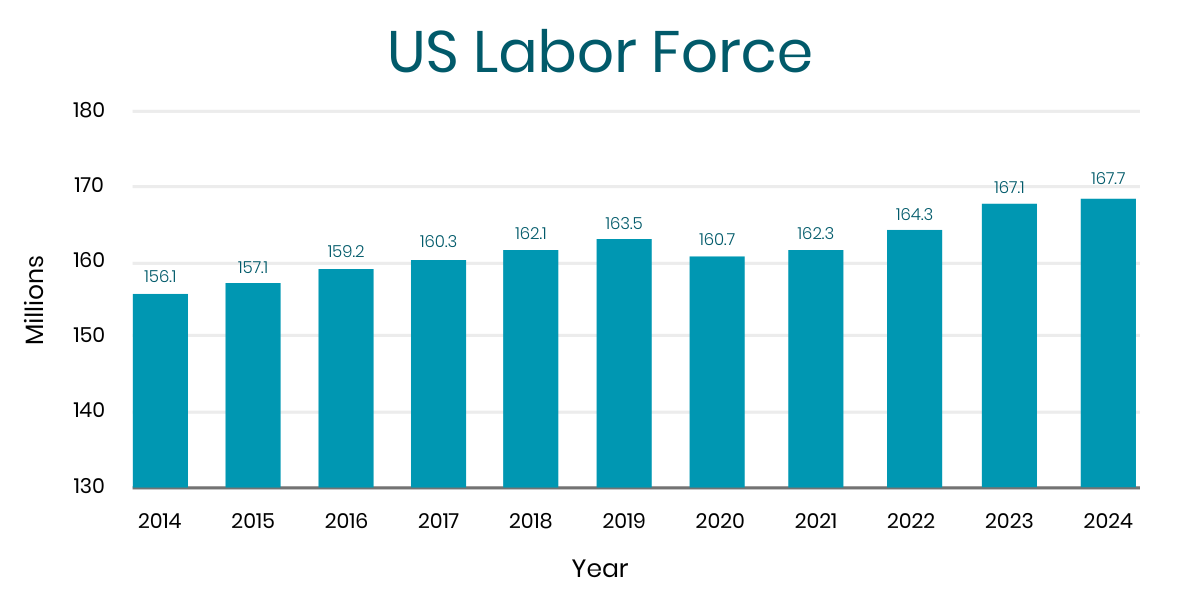Labor Market Focus: How Shifting Demographics are Changing the Workforce
August 5, 2024
The Labor Market is constantly changing. Workers enter the market, others exit, but the makeup and characteristics of workers are also changing, and shifting US demographic trends are altering the composition of the labor force. In the the latest in our series Labor Market Focus, we examine some of the key demographic trends in the labor force, and what they suggest for HR and organizational leaders.
Introduction
As of May 2024, the estimated size of the U.S. civilian labor force is approximately 167.73 million people. This includes individuals who are either employed or actively seeking employment. The term civilian labor force is used by the U.S. Bureau of Labor Statistics (BLS) to describe the subset of Americans who either have jobs (employed) or are seeking a job but not working yet (unemployed), are at least 16 years old, are not serving in the military, and are not institutionalized.
The labor force has been steadily growing over the last decade, rising from 156 million workers to the near 168 million workers reported in May. This rise is generally in line with the overall growth in the population. But within the labor force, shifting demographics are expected to bring significant changes to the composition of the workforce, and will force HR and business leaders to adapt. In this H3 HR Insight, we’ll examine the current state of the labor force, highlight some of the changes and trends in workforce demographics, and share some ideas on how HR leaders can and should prepare for what’s coming.
The Current Composition of the US Labor Force
Here is the estimated breakdown by generation of the current U.S. labor force :
- Baby Boomers (born 1946-1964): Approximately 19% of the workforce or about
- Generation X (born 1965-1980): Nearly 36% of the workforce or about
- Millennials (born 1981-1996): Just over 40% of the workforce or about
- Generation Z (born 1997-2012): A little over 6% of the workforce or about
These percentages reflect the general representation of each of the age groups participating in the U.S. labor market. But since the members of the workforce, and the underlying and contributing population overall are constantly changing, these estimates are reflective of a point in time only. Looking at the Generations more closely, we see that each is evolving, and the combined effects impact the overall labor force, and trickle down to effect localities, industries, and individual organizations. Let’s examine some of the expected changes and trends for each of the Generational groups in the labor force.
Baby Boomers: Many Baby Boomers (born 1946-1964) will continue to retire, leading to a decrease in their representation in the labor force. However, some will remain employed longer due to financial necessity or personal choice. More on the impact of increasing Boomer retirements below.
Generation X : For Gen X’ers (born 1965-1980), many are in the prime of their working careers, holding management and leadership positions in their organizations, or having built their own businesses. The older members of Gen X are approaching 60 years old, and beginning to contemplate, or even transition into retirement.
Millennials: For the large Millennial generation (born 1981-1996), they are also moving into more senior roles in their organizations. Many are also facing challenges of caregiving – both for young children as well as older parents. Millennials are the largest generation in the workforce, and they will continue to hold a significant share, although their growth rate will stabilize as they age into mid-career roles.
Generation Z : For Gen Z (born 1997-2012): This generation will see substantial growth in their labor force participation in the next 5 – 10 years as they complete their education and enter the workforce. They are expected to bring new skills and perspectives, particularly in technology and digital innovation. Notably, many in Gen Z, shaped by their experiences during the pandemic era, often bring different ideas about the role and importance of work in their lives, and are mindful of their mental wellbeing and their work/life balance.
Also worth noting are some more generalized, expected trends for those workers on the opposite ends of the labor force spectrum. For younger workers, aged 16-24 years the labor force participation rate for is expected to decline, partly due to increased educational attainment and delayed entry into the workforce. With more options available, younger workers’ participation tends to be lower. But many economists feel the opposite is likely for Older Workers: The number of workers aged 75 and older is projected to grow significantly, by about 96.5% from 2020 to 2030. This is due to several factors including expected increase in effective life spans, less social pressure to retire, and for some, lingering economic pressures making retirement less likely or attractive.
Boomers and the Impending Retirement Surge
Over the next few years, the labor market is expected to be significantly impacted by baby boomer retirements – and some industries will feel the pain more than others.
A record 4.1 million Americans are set to turn 65 this year and each year through 2027. Although not all those boomers will leave the workforce, the surge of new 65-year-olds probably will mean record retirements as well. The increase in number of retirees is expected to keep job openings elevated and force employers to raise wages to attract job candidates from a more slowly growing labor force. There were 8.1 million job vacancies in May, Labor Department figures show, down from a record 12.2 million in March 2022 but above the pre-pandemic average of about 7 million.
Through the first five months of the year, there have been about 900,000 retirements in the U.S., a pace that could result in a record 1.7 million to 2.1 million for the entire year. The figures are based on Social Security Administration data on the number of people claiming benefits for the first time.
By comparison, retirements averaged 1 million to 1.3 million from 2010 through 2019 before increasing to about 1.6 million last year, Social Security figures show. Although COVID-19 pandemic prompted many workers to retire early, nearly 500,000 people delayed retirement as the pandemic reduced their income or savings, and there’s much evidence suggesting retirement is becoming an unattainable luxury for some.
Still, many people who put off retirement during the pandemic are making the move now, further stressing the supply of workers in affected areas. Meanwhile, the arrival of new entrants into the workforce – most of them recent high school or college grads – isn’t keeping pace with increased retirements. In May, there were 2.8 retirees for each unemployed entrant to the workforce, the most on record and a ratio that has steadily climbed in the past 15 years.
The Workforce of 2025 and Beyond
Most estimates of the demographics of the labor force show a slow, but steady overall aging in its composition. In just five years, often used by many organizations as their typical planning window, we will see continued shifts in the generational composition of the labor force. The size of the US labor force in 2030 is projected to be approximately 168.8 million people, according to the U.S. Bureau of Labor Statistics. This represents a modest increase from the 2020 labor force, which was about 160.7 million. Here are some predictions for how the labor force will change in the next five years.
Makeup by Generation of the US Labor Force in 2030
The generational composition of the labor force in 2030 will be influenced by the aging and continued retirements of the Baby Boomers (and even some older GenX workers), and the entry of Generation Z into the workforce. Here’s a projected breakdown:
1. Baby Boomers (born 1946-1964): By 2030, most Baby Boomers will be over the age of 65 and many will have retired. However, a portion of this generation will remain in the workforce due to longer life expectancies and changing attitudes toward retirement. It’s estimated that they will make up a small percentage of the labor force, possibly around 5%.
2. Generation X (born 1965-1980): Generation X will be in their prime working years, aged between 50 and 65 in 2030. They are expected to represent a significant portion of the workforce, possibly around 25%.
3. Millennials (born 1981-1996): Millennials will be between 34 and 49 years old in 2030, continuing to be a dominant group in the labor force. They are expected to comprise the largest share, around 35%.
4. Generation Z (born 1997-2012): Generation Z will be between 18 and 33 years old in 2030, fully integrated into the workforce. Their presence will be substantial, making up around 30%.
5. Generation Alpha (born 2013-2025): By 2030, the oldest members of Generation Alpha will be entering the labor force at age 17. Their presence will be minimal, possibly around 5%.
These projections help us understand the evolving demographic landscape of the US labor force, highlighting the importance of Millennials and Generation Z in driving economic activity and innovation in the coming decade. In just a few short years the impact and influence of the large Boomer generation will be minimal, Millennials and Gen Z will combine to be almost two thirds of the workforce, and for the first time we will being to see Generation Alpha enter the workplace. These shifts will present both opportunities and challenges for HR and business leaders in all types of organizations. Let’s examine some ways to better prepare your organization to meet this moment.
Preparing and Leading a Multi-generational Workforce: Implications for HR Leaders
HR and business leaders can’t afford to ignore the key demographic trends in the workforce. Managing a multigenerational workforce can be both rewarding and challenging. Here are some important considerations and best practices for HR leaders and business owners as they navigate a workplace with four and soon to be even five separate generations of workers:
Important Considerations
1. Communication Styles: Different generations may prefer different communication methods. For example, Gen Z and millennials might favor digital communication, while Boomers and Gen X might prefer face-to-face or phone conversations. Gen Z have become famous (or infamous) for their looser communication styles and less formal approaches to written communication.
2. Work-Life Balance: Each generation may have different expectations regarding work-life balance. Millennials and Gen Z often prioritize flexibility and work-life integration, while Boomers might value more traditional work hours. However, many Gen Z workers look for in-person work as an important source of networking, learning, and socializing. Millennials are in the sweet spot of simultaneously growing in their careers along with household formation – making things like childcare benefits and schedule flexibility extremely important to this group.
3. Technology Adoption: Younger generations tend to be more tech-savvy and open to adopting new technologies, whereas older generations might need more training and support. With technology moving and evolving so rapidly, ensuring established workers are given the resources and time to keep up and learn new skills will be critical.
4. Career Development: Career aspirations and development needs can vary. Gen Z and millennials often seek rapid career progression and continuous learning opportunities, while Boomers might focus on stability and legacy. Establishing formal and informal connection and mentorship opportunities that cross generations can be one way to align earlier career workers with experienced mentors who have much insight and experience to share.
5. Values and Motivations: Understanding what motivates each generation is crucial. For instance, Gen Z values diversity and inclusion, while Boomers might prioritize job security and loyalty. Ample data has shown that Gen Z and Millennials expect to have considerable alignment in their personal values with their employer’s values and mission. And they want their leaders to take positions on cultural and societal issues that matter to them.
6. Workplace Accommodations: Particularly for older workers, organizations should consider making changes to physical workplaces, stations, and processes in order to support changing physical needs in the workforce. Updating workstations to allow more seated work for example, can allow older workers to remain effective and supported in their positions.
Best Practices for Managing the Multi-Generational Workforce
1. Foster Open Communication: Encourage open dialogue and create an environment where employees feel comfortable sharing their preferences and feedback. This helps bridge generational gaps and fosters mutual understanding. Find ways to be intentional on connecting workers from different generations both formally, as in project team creation, and informally, like at offsite meetings or community outreach activities.
2. Promote Inclusivity and Respect: Ensure that all employees feel valued and respected, regardless of their age. This includes addressing age-related biases and stereotypes and promoting an inclusive culture. Differences in age or generation need to be leveraged for the strengths and benefits that come with generational diversity – this should be a part of the organization’s comprehensive approach to diversity and inclusion.
3. Offer Flexible Work Options: Provide flexible work arrangements to accommodate different needs and preferences. This could include remote work, flexible hours, or part-time options. While workers of all generations report valuing flexibility, each group will have different needs and priorities at any given point of their life stage. Organizations have to remain nimble and open to these widely different sets of desires and work to create an environment that balances employee needs with business requirements and customer demands.
4. Tailor Training and Development: Customize training programs to cater to the learning styles and career aspirations of different generations. This can include mentorship programs, cross-generational training, and continuous learning opportunities. Often older and more experienced workers can be tapped to provide both formal and informal training and mentoring to newer and younger employees – giving both groups powerful and meaningful experiences.
5. Leverage Strengths of Each Generation: Recognize and utilize the unique strengths and perspectives that each generation brings to the table. Encourage collaboration and knowledge sharing across generations to drive innovation and productivity. Organizations should seek ways to let every group contribute their perspectives and their expertise. Imagine an environment where the enthusiasm and curiosity of youth is strengthened by the wisdom and experience of the more tenured workers – a win-win for all.
6. Educate Managers and Leaders: There are several important considerations for managers in organizations comprised of four to five generations of workers. Managers should be trained to understand the important elements of differing communication styles, work preferences, need for flexibility, technological acumen, and professional goals and how they change over time. Additionally, newer managers should be trained on ways to effectively lead when they may be younger and less-experienced overall than members of their teams.
By considering these factors and focusing on these best practices, HR leaders can help to shape an effective and productive multigenerational workforce that leverages the strengths of all employees.
Conclusion
In just the last few years we have seen some dramatic shifts in the generational composition of the labor force. While the overall labor force is growing only slowly, inside the workforce we are experiencing more significant change. The large Boomer generation, who has largely shaped the working world in the US since the 1970s, is finally leaving the workforce, almost fully, and the leadership void left behind is being increasingly being filled by Millennials and even Gen Z. Meanwhile, many Gen X workers are (as always) caught a little bit in the middle of these two larger groups, and struggling with many of the mid-to-late career challenges that rise from shifting workplace dynamics, new technologies, and considering their own post-career lives. Finally, the emerging Gen Z cohort is exploding on the scene at work and are ready to shake up many of the workplace’s traditions and norms. It is a challenging and exciting time to be in HR leadership today, and hopefully this article has provided some additional perspective and insight as you plan for and manage this always-evolving world of work.
How we can help
Led by Trish Steed and Steve Boese, H3 HR Advisors harnesses over 40 years of experience to delivery HCM insights and guidance to global organizations.
H3 HR Advisory services
By leveraging technology, analytics, and our deep industry knowledge we can help you to reposition your workforce and ensure that you have the right people with the right capabilities in the right roles to positively impact the growth of your business.
HR Happy Hour Podcast Network
Created in 2009, The HR Happy Hour Show is hosted by Steve Boese and Trish Steed and is the longest continuously running internet radio show and podcast on Human Resources, HR Technology, Talent Practices, Workplace and Leadership topics.
H3 HR Speaking Services
We work closely with every client to customize your content - keynotes, webinars, research, infographics, and buyer’s guides - to inspire, educate and inform the audience enabling you to reset and realign your organization for a talent-led breakthrough.
Get in touch
Talk to us today and find out how we can help you and your organization leverage HCM technology to attract, onboard, retain and manage top talent.




